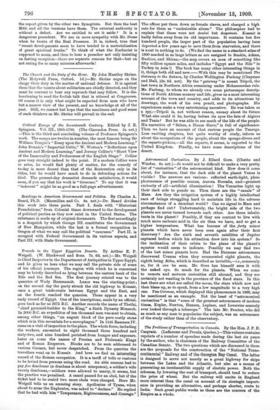Travels in the Upper Egyptian Deserts. By Arthur E. P.
Weigall. (W. Black-wood and Sons. Is. 6d. net.)—Mr. Weigall is Chief Inspector in the Department of Antiquities in Upper Egypt, and he gives us here what we may call the private side of some of his official journeys. The region with which he is concerned may be briefly described as lying between the eastern bank of the Nile and the Red Sea. The first journey related was to the quarries of Wady Hammamat. Luxor was the starting-point ; on the second day the party struck the old highway to Kossair, once a great trade-route between Egypt and the East, and on the fourth reached the quarries. These appear in a very early record of Egypt. One of the inscriptions, made by an official, goes back as far as 2675 B.C. Another records the name of Thethi, " chief pyramid-builder to the King," a Sixth Dynasty Monarch. In 2000 B.C. an expedition of ten thousand men was sent to obtain, among other things, "an august block of the pure costly stone which is in this mountain for a sarcophagus." In 1145 Rameses IV. came on a visit of inspection to the place. The whole force, including the workers, amounted to eight thousand three hundred and sixty-two, and nine hundred perished from hunger and exposure. Later on come the names of Persian and Ptolemaic Kings and of Roman Emperors. Blocks are to be seen addressed to various Caesars, but never despatched. From the quarries the travellers went on to Kossair. And here we find an interesting record of the Roman occupation. It is a tariff of tolls or customs to be levied from persons using the road. An able seaman had to pay five drachmas (a drachma is about ninepence), a soldier's wife twenty drachmas,—soldiers were allowed to marry, it seems, but the practice was penalised. A camel passed for an obol, but if the ticket had to be sealed two more obols were charged. Here Mr. Weigall tells us an amusing story. Apollonius of Tyana, when about to cross the Euphrates, was asked to " declare." He replied that he had with him " Temperance, Righteousness, and Courage." The officer put them down as female slaves, and charged a high rate for them as "undesirable aliens." The philosopher had to explain that these were not dou/ai but despainai. Kossair is badly fallen away from its old importance. It contains but five hundred people, the larger part of the population having been deported a few years ago to save them from starvation, and there is next to nothing to do, (We find the name in a standard atlas of 1890 marked in as large letters as are assigned to Suakin, Adana, Bushire, and Shiraz,—the map covers an area of something like fifty million square miles, and includes "Egypt and the Nile" in Turkey in Asia!) The book has many other interesting things in it, things both old and new.—With this may be mentioned The Gateway to the Sahara, by Charles Wellington Furlong (Chapman and Hall, 12s. 6d. net). By the " gateway " is meant Tripoli, the last town in Northern Africa remaining under Mohammedan rule. Mr. Furlong, to whom we already owe some picturesque descrip- tions of North African scenery and life, gives us a most interesting account of the town and country, and adds to its attractions by drawings, the work of his own pencil, and photographs. His experiences make a very entertaining narrative. He was taken as a spy,—Tripoli is, not without reason, uneasy about its future What else could it be, having before its eyes the fate of Algiers and Tunis? But he was able to see much of the life of the people. His narrative of " &lam, a Hausa Slave," is full of significance. Then we have an account of that curious people the Tuaregs. Less exciting chapters, but quite worthy of study, inform us about the occupations of the people, about the sponge-divers and the esparto-pickers,—all the esparto, it seems, is exported to the United Kingdom. Finally, we have some descriptions of the desert.














































 Previous page
Previous page